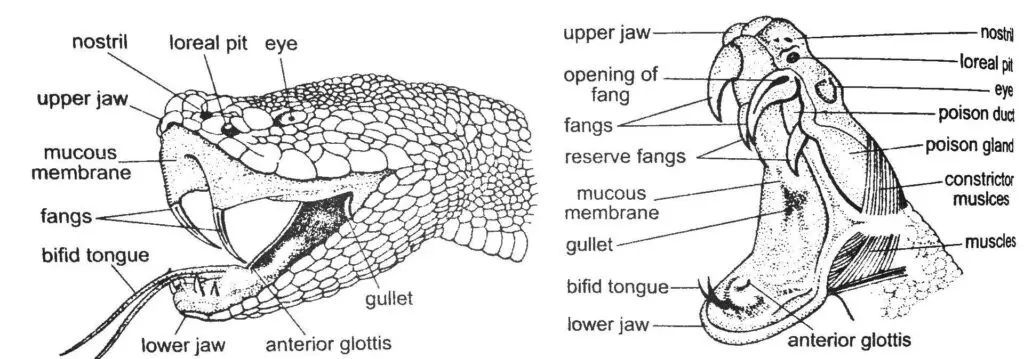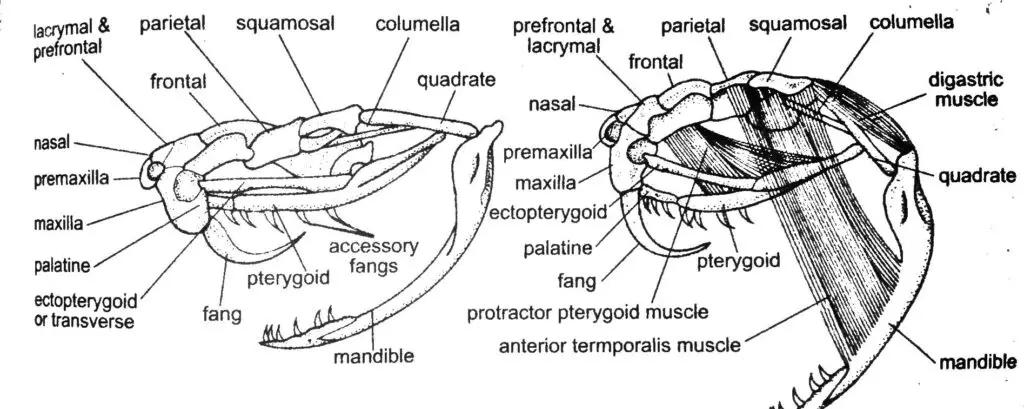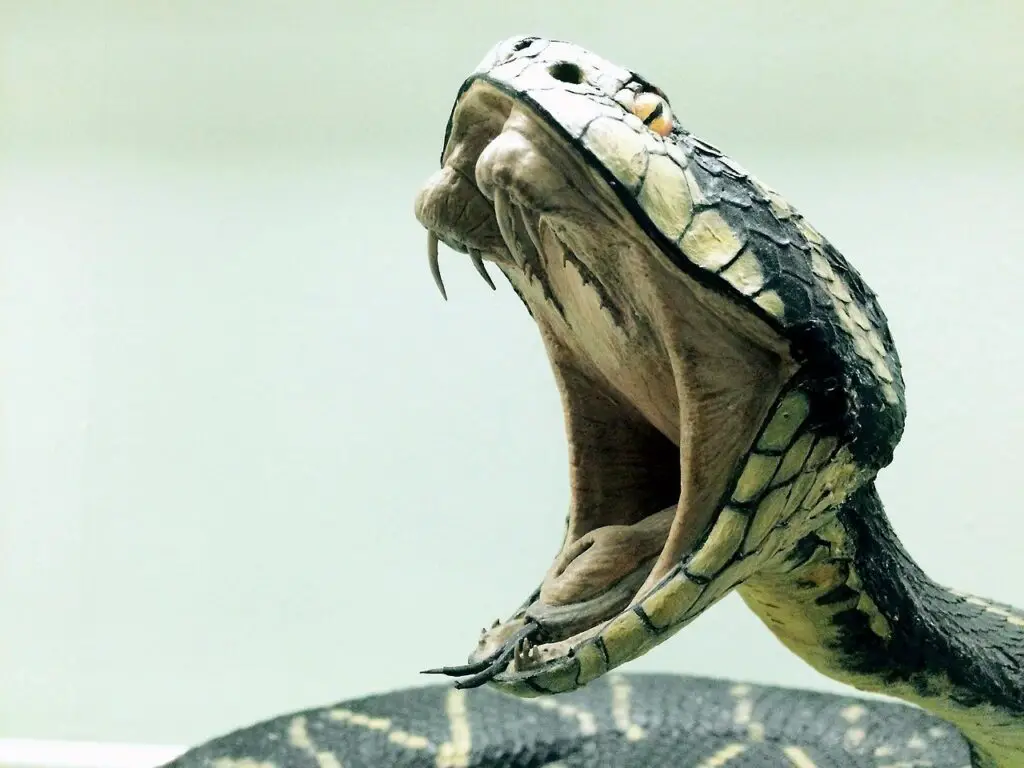How Do Snakes Bite? (Biting Mechanism of Snakes)
In this post, you will learn how a snake uses its skull bones, teeth, and muscles to systematically close and open its mouth in order to strike and then bite its prey.
Here, you learn the complete biting mechanism of snakes in detail and easy to understand the concept. So, just keep reading…
Snakes are all reptiles. They belong to Class Reptilia of the Sub-phylum Vertebrata of the Animal Kingdom.
People usually consider all the snakes as venomous, but only about 20% of the snake species are venomous in nature.
This literally means that out of more than 3000 species of snakes in the world, some 600 are venomous and over 200 are considered to be medically important.
Venom helps the snakes to get on their prey and kill it very easily. On the other hand, non-venomous snakes have also developed some kind of a mechanism to get on their prey without the use of any venom.

How do snakes bite?
The mouth of a snake is capable of being widely opened by the free articulation of the lower jaw.
This means that the upper jaw doesn’t move a lot and it’s mostly fixed and only the lower jaw wide opens.
They bite with the help of their sharp-pointed, backward-curved teeth that are located on their upper jaw and lower jaw.
The teeth of the upper jaw are arranged in 4 rows parallelly and that of the lower jaw is arranged in two rows with one row at one side of the jaw.
The teeth of the upper jaws chiefly serve to bite and hold the prey when it is being swallowed. While those of the lower jaw helps to hold the prey as well as to bite it.
Poisonous snakes can have fangs (poison teeth) through which they can bite their prey or in defense and insert the poison.
Non-poisonous snakes on the other hand do not have fangs to bite, and if available these don’t have poison in them.
In general, a majority of the snakes contain only a pair of fangs with one fang at one side of the upper jaw. While there are snakes like the rattlesnake that possesses two pairs of fangs with two fangs at one side of the upper jaw.
For biting snakes use 3 types of muscles. These are Digastric muscle, Sphenopterygoid muscle, Anterior & Posterior temporalis.
The Digastric muscles help in opening the mouth by releasing the lower jaw. The Sphenopterygoid muscle helps to erect the fangs and teeth of the upper jaw. And, the Anterior & Posterior temporalis muscle helps in closing the lower jaw.
With the proper and systematic use of the teeth and these 3 types of muscles, the snakes are able to bite. They are also able to swallow their prey as well.

The Biting Mechanism of Snakes
Let’s understand the biting mechanism of snakes pointwise:
1. At first, the Digastric muscle contracts and this helps in relaxing the lower jaw leading to the opening of the mouth by releasing the lower jaw.
2. As the mouth opens the lower jaw of the mouth moves down and the lower end of the quadrate bone moves forward.
3. As the quadrate bone moves forward, this leads to the pterygoid bone to also move forward.
4. As the pterygoid bone also moves forward, this leads to the pterygo-palatine joint to bent.
5. The bent of the pterygo-palatine joint leads to the erection of the teeth located on the upper jaw.
6. The contraction of the Sphenopterygoid muscle also helps to erect the fangs and teeth of the upper jaw.
7. As the pterygo-palatine bone joint bents, this also leads to the erection of maxilla bone to rotate at an angle of 90°.
8. The rotation of the maxilla bone at a 90° angle causes the fangs to erect. Thus the fangs get projected downwards at the front end of the mouth.
9. The contraction of the digastric muscle also leads to the relaxation of the posterior ligament which eventually rotates the squamosal bone. This leads to squeezing the wall of the poison gland and as a result droplets of poison can come out through the fangs.
10. Next, as the mouth gets opened and the fangs get erected, the snake with the help of the strips of neck muscles arranged in the neck-trunk junction can throw itself forward with great rapidity and violence in order to bite its prey. They can strike and bite very fast.
11. After the biting is done, the snake will soon close its mouth.
12. First, contraction of the Anterior & Posterior temporalis muscle helps in closing the lower jaw.
13. Next, the relaxation of the Digastric muscles and the Sphenopterygoid muscle help the maxilla bone to get back to its original shape.
14. The pterygo-palatine bone joint soon unbent as the quadrate bone shifts backward. This leads to the complete closure of the mouth.
15. It is seen that it takes a longer time to open the mouth than to close it.
Why do snakes bite?
Non-poisonous snakes can bite to catch and hold on to the prey and kill it in order to swallow. Or they may even bite for defending themselves in case of danger.
Poisonous snakes on the other hand can directly insert their fangs into the body of the prey or in case they feel they are in danger. The poisons are neurotoxic and can be very deadly.
Poisonous Snakes commonly include elapids (such as kraits, cobras and mambas), vipers, and sea snakes. They bite with their fangs and kill their prey with the poison and then feed on it.
The majority of snake species are non-poisonous (example: Anaconda) and so they do not have venom and kill their prey by squeezing them. Some can even bite to hold the prey and then squeeze to death to feed on it.
Snakes can even bite humans in self-defense just in case they feel they are not safe. This shouldn’t be confused with that of the same bite to kill the prey and feed on it until and unless the snake is a large anaconda or reticulated python perhaps.
We all know that the snakes do not have any kind of limbs or hands to protect themselves. The thing is that they only bite out of defense.
It is also interesting to note that, venomous snakes can give a warning bite in defense as well. This simply means that venomous snakes will not inject venom when they bite. It’s only a warning bite from their side.
Remember, the main purpose of the poison in venomous snakes is just to kill the prey and feed on it.
But, just in case, you get bitten by a poisonous snake don’t take the risk thinking that they haven’t inserted the poison inside your body.
Snakes bite as an innate reflex when it senses that it is in danger. If you’re asking why they bite humans, it’s because they deem humans a threat.
How fast do snakes strike and bite?
Both striking and biting speed of the snake is measured by their acceleration rates using the measurement of meters per second squared, or m/s2.
Meaning that when an object accelerates at 1 m/s2 its speed increases by 1 m/s.
Snakes can strike and bite with a maximum speed of 2.74 meters per second to 2.95 meters per second. That’s faster than the reaction time of an animal to save itself.
Some of the fastest ones known so far are the rattlesnake having an average strike speed of 2.95 meters per second, the cottonmouth with 2.98 m/s, and the rat snake with 2.67 m/s.
Snakes are well known to accelerate their heads, with the rate of 190 m/s2, and so are just super-fast to strike and bite their targets in just 50 to 90 milliseconds.
The fastness of a snake to strike and bite is just a lot faster than the blink of a human eye.
The blink of an eye typically lasts on average 220 milliseconds, while that of both striking and biting speed lasts for about 50 to 90 milliseconds.
If we only talk about the speed of the nonvenomous rat snake which accelerates at about 274 m/s2, that’s lightning-quick.
If you simply consider the attack speed of the nonvenomous rat snake to that of a Formula One race car, then the snake will actually win. It’s because the car accelerates at less than 27 m/s2 to go from 0 to 60 speed in just one second.

Parts of the snake’s mouth used in biting
Skull Bones
The skull of the snake is very free moving and kinetic in nature.
You will find many joints and moving parts in their skull that help them to move their left and right sides of their jaws independently.
The quadrate bone helps in moving the upper jaw forward that helps in the contraction of muscles to open the lower jaw.
The pterygo and the palatine bones helps in the erection of the teeth in the upper jaw.
The rotation of squamosal bones helps in the release of poison from the poison glands.
The maxilla controls the erection of the fangs at an angle of 90° bringing the fangs projected downwards at the front end of the mouth.
The premaxillary bone is single and small and helps control the maxillary.
The lower jaw ramus gives the lower jaw the shape and movement capacity.
Dentition
In snakes, the teeth are located on the dentary of the lower jaw, the maxilla, the palatine bone, and the lateral pterygoid plate.
The maxilla, the palatine bone, and the lateral pterygoid plate are part of the upper jaw, while the lower jaw contains only the mandible where the lower jaw teeth are arranged.
The teeth of the palatine bones and the pterygoid plate help in holding the prey while swallowing it.
The maxilla contains a pair of fangs that are connected to the poison glands via. the poison ducts.
The “inner row” teeth of the upper jaw can move separately from the rest of the jaws and are used to help “walk” the jaws over prey.
The teeth of the upper jaw are arranged in 4 rows parallelly and that of the lower jaw is arranged in two rows with one row at one side of the jaw.
Muscles
3 types of muscles are there in the skull that controls the mouthparts. These are Digastric muscle, Sphenopterygoid muscle, Anterior & Posterior temporalis.
The Digastric muscles help in opening the mouth by releasing the lower jaw.
The Sphenopterygoid muscle helps to erect the fangs and teeth of the upper jaw.
The Anterior & Posterior temporalis muscle helps in closing the lower jaw.
Poison Apparatus
The poison apparatus is only present in poisonous snakes. The poison apparatus can have a pair of poison glands, a pair of poison ducts, and a pair of fangs.
Each poison gland is a sac-like gland that is provided with a narrow duct at its anterior end. Each gland is located at each side of the upper jaw.
The poison glands are the modified posterior labial gland. From the anterior end or neck of each poison gland arises a poison duct.
Each fang is located on the maxilla on each side of the upper jaw. In poisonous snakes, some of the maxillary teeth become poison fangs.
The poison duct passes forward along the side of the upper jaw and loops over itself just in front of the fang and opens either at the base of the fang or at the base of the tunnel on the fang.
How Do Snakes Eat?
Now that you have learned about how the snake strikes and then bites its prey, you can also learn how the snake eats by feeding and swallowing its food after biting and holding its prey.
READ NOW: How Do Snakes Eat? (Feeding & Swallowing Mechanism)
